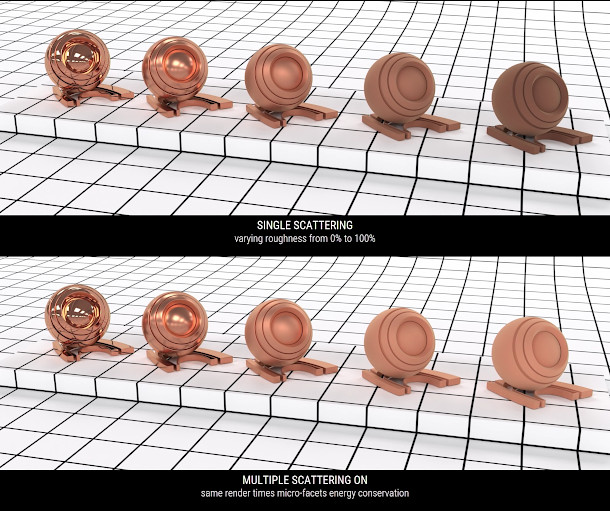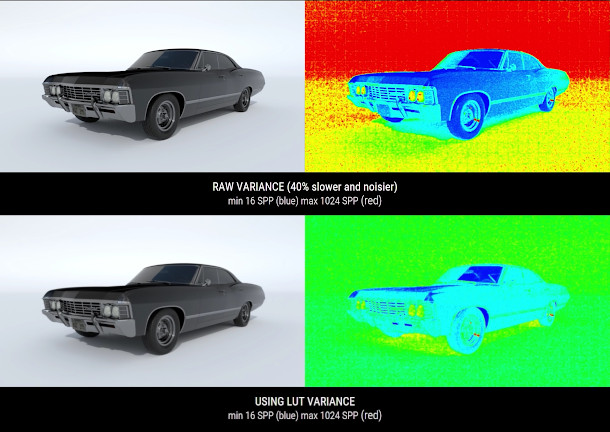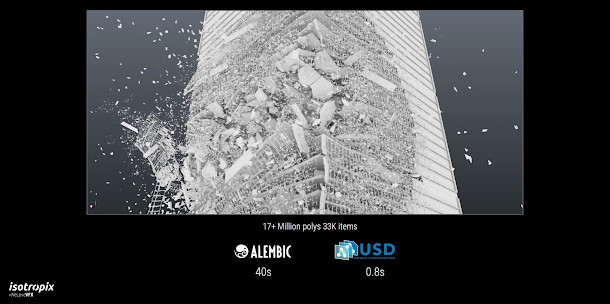Isotropix ships Clarisse iFX 4.0
Originally posted on 6 September 2018. Scroll down for the commercial release and pricing changes.
Isotropix has previewed some of the new features coming up in Clarisse iFX 4.0, the next major update to its set dressing, lighting and rendering software.
The update will introduce a complete revamp of the lighting model that aims to do away with conventional CG light types entirely, and improves rendering of matte surfaces and handling of anti-aliasing.
Other features include new AOVs and display modes for troubleshooting scenes, the option to generate Playblasts from the 3D view, and support for SeExpr expressions, layered Alembic files and the USD format.
The presentation above was given at Siggraph 2018, but has only just been posted on YouTube.
A hybrid set dressing, look development and rendering tool
Combining features of conventional renderers, compositors and DCC tools, Clarisse iFX is designed to enable artists to develop heavy production scenes while interacting continually with the final image.
First released in 2012, the software has quickly carved out a niche in high-end visual effects, and is now in use at a number of major facilities, including ILM and Double Negative.
Although initially described as a hybrid 2D/3D rendering system, the software also features well-developed toolsets for shot layout – particularly set dressing and object scattering – and look development.
Its branding has also evolved, having briefly become plain old ‘Clarisse’ before reverting to its original name on the release of a new node-based, super-high-end edition, Clarisse Builder, earlier this year.
New in Clarisse 4.0: an entire new workflow for CG lighting?
One of the most striking changes due in Clarisse 4.0 is the ground-up reworking of its lighting model: one which introduces what Isotropix hopes will become an entire new workflow for lighting CG scenes.
The update enables users to turn any arbitrary geometry into a light by attaching an emissive material. Geometry lights can then be scattered throughout a scene as if they were standard 3D objects.
When rendering, Clarisse treats geometry lights differently to conventional emissive geometry, with the option to use Multiple Importance Sampling rather than the material sampling attributes of the path tracer.
According to Isotropix CEO Sam Assadian: “The renderer doesn’t necessarily sample each light individually [making it possible to] render billions of lights. It’s just magical.”
Isotropix’s “mid-term goal” is to replace “traditional concepts of light [with this] very intuitive method”.
While it will still be possible to create traditional CG light types within Clarisse, the software will treat them internally as if they were geometric lights.
Updated 5 April 2021: The geometry lighting system was later dropped from Clarisse iFX 4.0 due to difficulties balancing interactive performance and render quality, but has now shipped in Clarisse 5.0.
Support for portal lights and IES light profiles
Other new lighting features, shown from 12:00 in the video at the top of the story, and in more detail above, including portal lights, intended for mimicking illumination from windows and doorways in interior scenes.
The update will also introduce support for IES light profles, and options for adjusting their settings.
Representations of the falloff patterns of real-world light fixtures, IES profiles are widely used in the visualisation market, but have historically been less common in entertainment work.

Multiple scattering improves rendering of matte surfaces
New shading features in Clarisse iFX 4.0 include multiple scattering for reflected and transmitted light.
The software’s previous single scattering model minimised computation times, but caused surfaces to darken unrealistically as their roughness values increased.
The new implementation (shown above) approximates true multiple scattering – “while [it isn’t] strictly Lambertian diffuse reflection, it’s very close” – and is fully energy-conserving.
According to Isotropix, it has no impact on render time, and will be enabled by default.

Adaptive anti-aliasing cuts render times without affecting image quality
The update also introduces support for adaptive anti-aliasing, enabling Clarisse to focus samples in the areas of a render where they are most needed, reducing render times without affecting image quality.
One nice feature is the option to specify the LUT that will be used for the final image when computing sample variance, which greatly improves sampling efficiency, as shown in the image above.
New diagnostic display modes let you generate heat maps to troubleshoot complex scenes
The image also demonstrates another new feature in Clarisse iFX 4.0: its diagnostic display modes.
Any image channel or AOV can now be displayed as raw output, a normalised black-and-white image, or a blue-to-red RGB heatmap.
The display can be used to visualise sampling values or render times for different parts of an image, helping TDs to troubleshoot complex production scenes.
Other rendering features: generate custom AOVs from 3D layers, or use 3D layers as matte objects
Other new rendering features include the option to generate custom AOVs on a scene level by plugging an AOV Store into a 3D layer, rather than having to do so for every material in the scene individually.
3D layers can also be used as matte objects, making it easier to generate holdouts in renders.
Set dressing: new Transform tool, surface constraint and density cutoff
Set dressing features include a new Transform tool, which enables users to move, scale and rotate objects in the viewport using a single universal gizmo.
Clarisse iFX 4.0 also features a new volume density cutoff setting, which can be used to make volumetric objects “look more meaningful” in the 3D view without the need to launch an interactive render.
At 14:15 in the video at the top of the story, you can see the feature in action to ‘clip’ a smoke plume, changing its height and overall form.
There is also a new surface constraint, which can be used to attach scene items to a deforming surface: for example, making it possible to parent geometry or lights to an animated character.
It is also now possible to generate Playblasts directly from the 3D view, enabling artists to preview animations quickly. Playblasts can use Clarisse’s built-in GPU denoiser.

Support for layered Alembic caches and USD import
Clarisse iFX 4.0 will also introduce support for Alembic 1.7, which will make it possible to import layered Alembic caches into the software.
It will also add support for the USD format, which Isotropix believes will soon replace Alembic in production: not simply because it is more feature-rich, but because it represents complex geometry more efficiently.
At 21:00 in the video at the top of the story, you can see a series of assets imported into Clarisse iFX in both Alembic and USD format.
In the case of the asset above, which comprises 33,000 individual objects totalling 17 million polygons, the Alembic file loads in 40 seconds and the USD file in 0.8 seconds: a 50x speed increase.
SeExpr makes it possible to control scenes with mathematical expressions
Clarisse iFX 4.0 will implement another key open technology: Disney’s SeExpr expression language.
Also supported in tools like Maya – it was originally developed for the XGen instancing system – and RenderMan, SeExpr enables TDs to control any aspect of a scene by constructing mathematical expressions.
Support for tiled rendering and crash recover in CNode
Outside the core application, CNode – the GUI-free edition of Clarisse designed for render farms – gets support for tiled rendering, making it possible to divide a single frame between multiple render nodes.
There is also a new crash recovery system, which makes it possible to skip completed tiles when re-rendering a frame after a crash, reducing overall render times.
Isotropix says that the features shown in its Siggraph demo only represent part of the feature set in Clarisse iFX 4.0, and that it will be announcing more in the run up to the commercial release.
Updated 1 February 2019: Isotropix has released Clarisse iFX 4.0 publicly.
As it turns out, the Siggraph demo showed the bullk of the new functionality: the only additional features listed on Isotropix’s website are improvements to mip-mapping (above) and handling of OpenColorIO.
However, the delay in shipping – version 4.0 was originally due before the end of 2018 – enabled Isotropix to put out a final service pack for Clarisse iFX 3.6 adding suppport for Disney’s Principled shader model.
Prices up slightly for studio licences, CNode down, educational licences now free
Isotropix has also reworked the licensing of Clarisse iFX for studios, reintroducing nodelocked licences – dropped in 2017 – at $2,299 each, and raising the price of floating licences to $2,999.
The price of 30-day rentals is also up slightly, to $399.
However, the cost of CNode is down significantly, from $899 to $549 for a perpetual floating licence, with rental now starting at $29/week, down from $39/week.
Teachers also now get one-year educational licences of Clarisse iFX for free, as do students at institutions that already teach Clarisse iFX: other students stay on the existing $59/year deal.
The ‘Clarisse iFX for Indies’ deal, which enables solo artists to buy a single nodelocked licence of Clarisse iFX for $999, remains unchanged.
Pricing and availability
Clarisse iFX 4.0 is available for Windows 7+, RHEL and CentOS 6+ Linux and Mac OS X 10.9+. Prices are listed in the story above. See more rental and education options here.
At the time of posting, Isotropix is offering studios 10 free perpetual floating CNode licences with every new perpetual floating licence of Clarisse iFX they buy. The offer runs until 30 April 2019.
Read more about the new features in Clarisse iFX 4.0 on Isotropix’s blog
